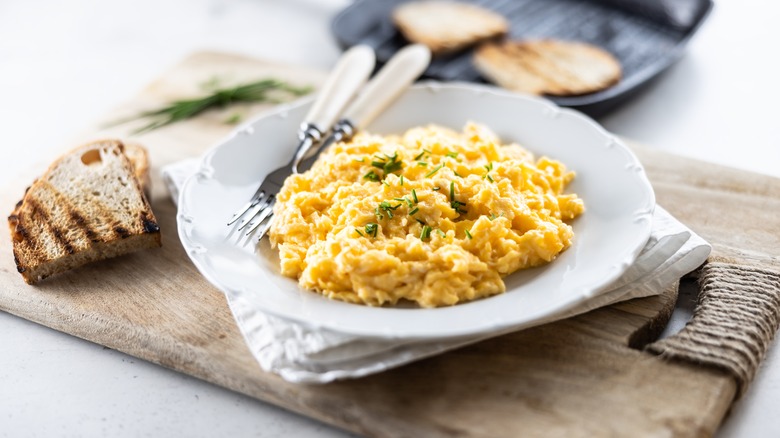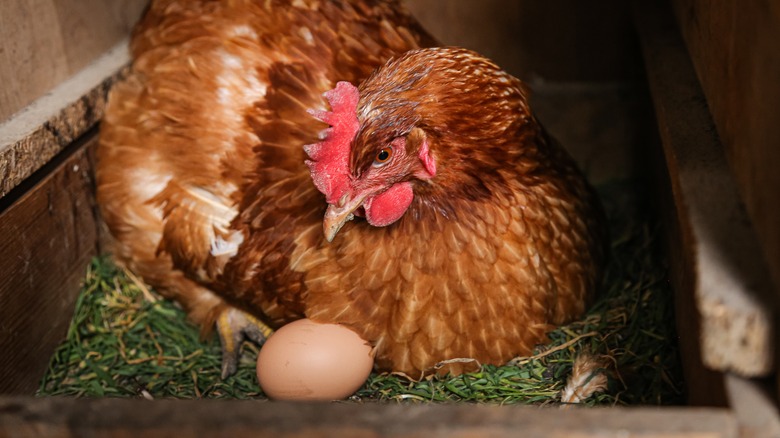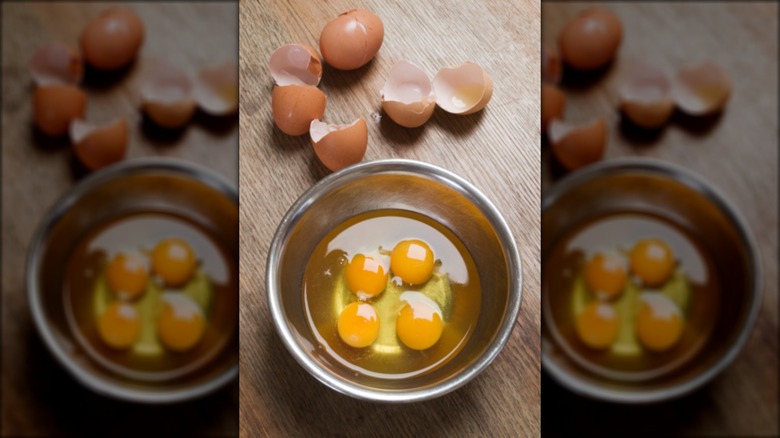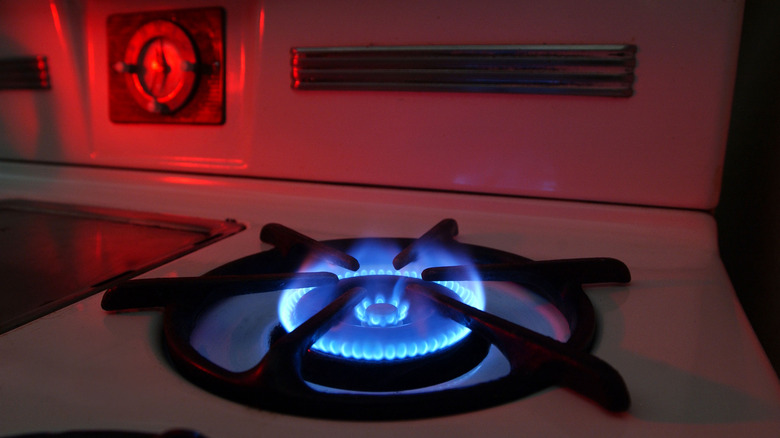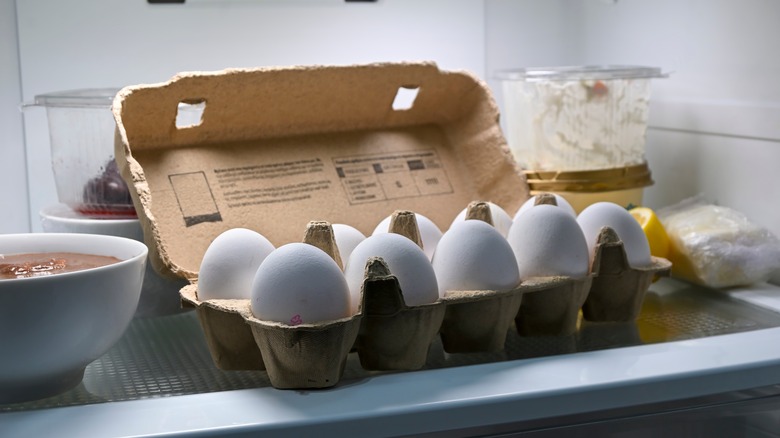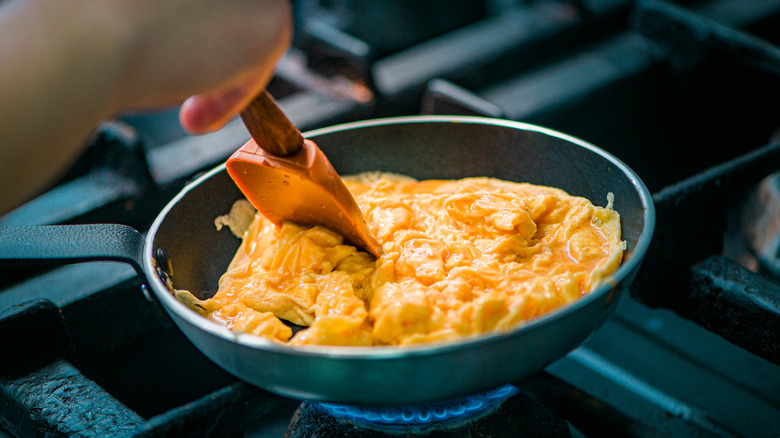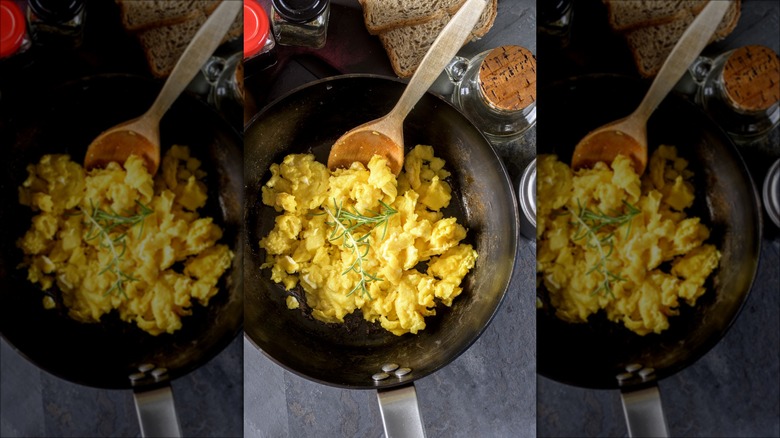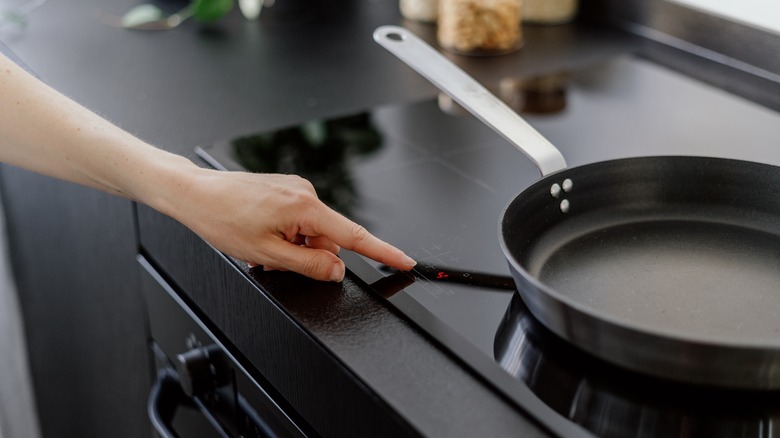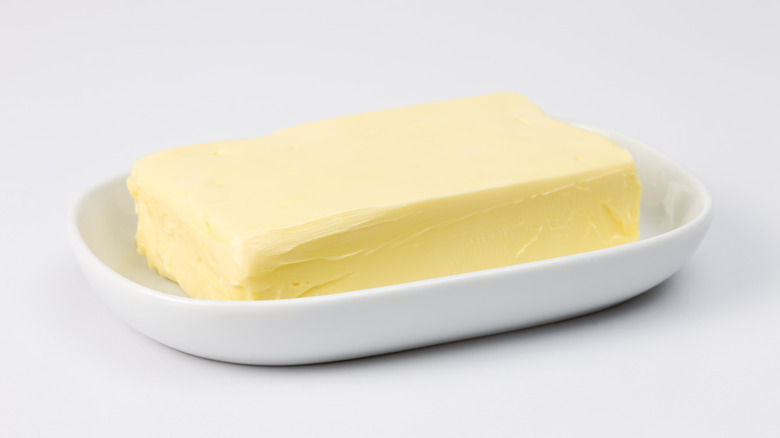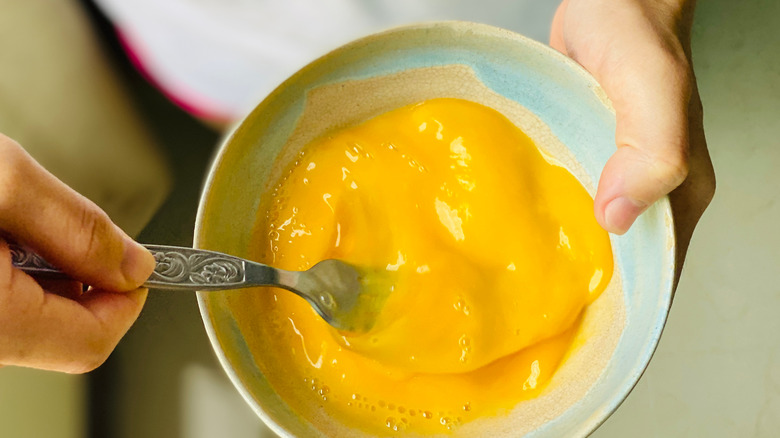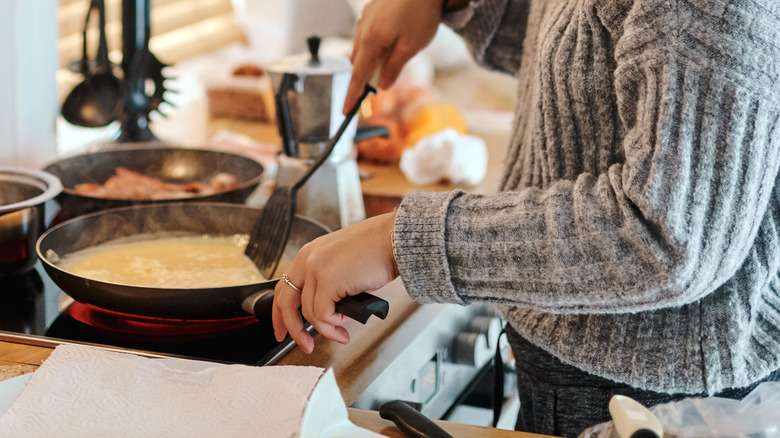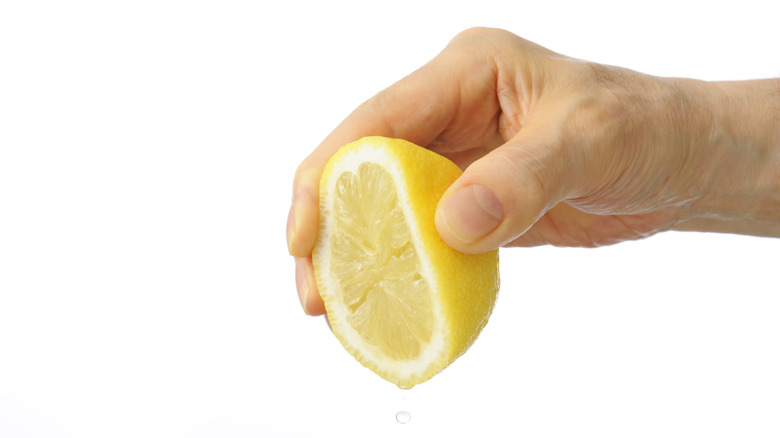Secrets For Making The Best Scrambled Eggs
Do a quick Google search of the "best tips for cooking scrambled eggs," and you'll likely meet with an abundance of offerings. Some will be practical and immediately useful. Others qualify as skills you'd like to have down the road, like maybe right after you down the pan of scrambled eggs you're trying to cook at this very moment. And from cooking blog to cooking blog, you'll read contradictory advice. It can be difficult to weed through all those scrambled egg tips.
Here's a secret to scrambling eggs that isn't such a secret. There's more than one way to cook 'em, and if any of those methods produce results, they're not bad to try. However — and that's a big "however" — they may be the wrong method for you, depending on where you're at in your egg cooking journey. That's why the best lists of scrambled egg cooking tips offer you plenty of different ideas that you can mix and match until you find the right ones for your cooking style. Think of it this way: If you gravitated toward one way to cook the eggs, but it didn't work, you have several other ideas to try until you land on the ones that work for you.
And this list of secrets for making the best scrambled eggs gets you started. Try one of them, four or five of them, or all of them. You're bound to learn a lot and end up with some perfect-for-you scrambled eggs, too.
1. Farm fresh eggs taste best
There are about a gazillion reasons to make your scrambled eggs from farm-fresh eggs if that's an option for you. It's even better if you're among those who own backyard chickens and have their own eggs. Here's how this unpacks. In general, fresh eggs cook better and taste better. When you have access to fresh eggs every day, you typically eat them within a couple of days. However, store-bought eggs are often weeks, if not months, old by the time they hit the store shelves. Even if you eat them right away, they won't be as fresh. Their age becomes apparent when you crack them open. The whites run like a faucet because they're starting to break down. This affects the taste as well as how well they cook. Old eggs can also taste like sulfur and ammonia, while fresh eggs come with a more mild taste.
But that's not the only thing that influences the taste. What the chickens eat also affects the taste, which can differ drastically between commercially-raised hens and homestead hens. The egg yolks turn a darker orange which indicates more nutrition in the yolk. These nutrients come from their diet. The yolks in fresh eggs tend to hold their firmness, too, giving you nicer scrambled eggs. If you don't have access to your own backyard chickens, try finding a place that sells free-range eggs. The egg quality will likely be better than you'll find in the regular grocery store.
2. Crack your eggs into a dish first
Not cracking eggs into a smaller dish before you begin scrambling them appeals to those efficient foodies who don't want so many dishes to clean up after cooking ends. This desire makes sense. However, not using a smaller intermediary egg bowl opens up the door to tiny shell crumbles ending up in your scrambled eggs. Breaking your eggs into a smaller dish before you put them into the frying pan is as close as you're going to get to not having crunchy, shell-filled scrambled eggs.
When you crack the eggs on the side of the skillet and dump the egg directly into the pan, there are more chances for small pieces of shell to break off and more to the point, fall into the pan. It's harder to fish those shell crunchies out of the frying pan because if the pan's hot, the eggs will immediately start to cook around the shells. If bits of the eggshell wind up in the intermediary bowl or cup, it's much easier to remove them because the eggs haven't started to cook yet.
3. Turn the burner off
Because eggs cook so quickly, it's easy to overcook them when you're scrambling your eggs. One of the best ways to avoid this eventuality is to turn off the burner just a little bit before you think the eggs are done. There's a momentum that kicks in once cooking begins. As such, the cooking process will continue inside the pan once the burner gets shut off. Even though the burner flame has gone dark, the eggs continue to cook for a few until the pan cools down or until you put the eggs onto plates to serve. If you're concerned about undercooked eggs, putting a lid on the pan keeps some of the heat inside. Just remember to take the skillet off the burner once you do this because most burners remain hot for several minutes after they've been turned off.
A bit of cold, flavored butter, like truffle butter, added to the scrambled eggs puts a complete stop to the cooking process. It's a technique you can employ if you're worried about the eggs overcooking despite being pulled from the flame, plus it makes the eggs taste delish to boot.
4. Cold eggs slow down cooking times
The temperature difference between the fridge and the bottom of the egg skillet is quite pronounced. Trying to scramble eggs that you've taken from the cold fridge and dumped into the heated pan causes a heat fluctuation. This affects how the eggs cook. Or not. The solution to this lies in allowing your eggs to sit out for 20 to 30 minutes before you pour them into the skillet. This reduces the temperature spread between the very cold eggs and the hot pan, encouraging a more even cook in the process.
For reference, here's the difference in those temperatures. In ideal conditions, your fridge runs at about 40 F. Food that is between 68 F and 70 F is considered room temperature. Scrambled eggs require medium-low heat to cook, or 250 F to 300 F. While the space between 70 F and 250 F is still quite large, it's not as dramatic as 40 F and 350 F. Your 40 F eggs cool the skillet down a great deal making for unevenly cooked scrambled eggs.
However, it isn't just the cooking part that goes more smoothly if you just allow the eggs to warm up to room temperature. Letting the eggs get to room temperature affects the viscosity of the eggs, too. The eggs mix better if they are a bit warmer. This is especially helpful if you like to add milk or half-and-half to your eggs (which should also be room temperature).
5. The pan makes a big difference
If you were on a budget when you set up your kitchen, you may have gravitated toward a few all-purpose pans that allow you to cook everything from pasta to scrambled eggs. And while you probably don't cook the pasta in the egg skillet, your egg pan may not be the best frying pan (or skillet) for the job for a couple of reasons. First, the size of the skillet determines how well something gets cooked. For example, if you're scrambling just two or three eggs, but you have a 12-inch skillet, the outer edges of the pan run cooler, relatively speaking, because the outer portions of the pan hang way over the burner. Uneven is the best way to describe the cook job here.
While the most common egg pans run about 10 inches, you may actually be better served by an 8-inch pan if you live alone. That's a better size for cooking just two or three scrambled eggs at a time. (Figure on two or three eggs per person.) On the other hand, if you cook for a larger number of people, like more than three, the 12-inch skillet might offer a better option for you.
Aside from the size of the skillet, the kind of skillet or frying pan can help or hinder your egg-cooking efforts, too. Eggs stick to most pans, even with copious amounts of butter. A non-stick Teflon or ceramic skillet minimizes this.
6. Preheat the pan so the eggs don't stick
Despite being quick and mostly simple, one element of cooking scrambled eggs has troubled most egg fans at least once, if not multiple times, in their cooking lives. No matter what they do, they just can't seem to stop the scrambled eggs from sticking to the pan. They've tried non-stick pans. They've tossed so many butter pats into the pan it looked like they were throwing butter confetti. Still, they end up with scrambled eggs stuck to the skillet.
Some cooks get around this occurrence by preheating the pan (and adding in some fat or oil). The preheating of the pan works so well, that it's even possible to cook scrambled eggs in stainless steel pans with just a bit of oil. It's the preheating that makes the difference. And it plays such a critical role in getting non-sticky eggs from the pan that it's even a recommended cooking tip when you cook eggs in a non-stick pan.
A couple of things should be mentioned here. Experienced chefs don't always preheat the pan. Starting scrambled eggs with a cold pan is a trick that Gordon Ramsay has mastered, and it's a skill set that you, as a non-professional chef, may put on your cooking skills bucket list. But until you also master scrambling eggs in a cold pan, you shouldn't stop yourself from trying a preheated pan in the meantime.
7. Keep the heat low
High heat dries eggs out and can turn them a little rubbery. Heat denatures the protein in the eggs. This basically breaks apart the proteins in the eggs and then restructures them into a new form, in this case, your scrambled eggs. In the process, the eggs basically kick the water content out of the egg, turning the egg's protein into a solid.
Low heat also denatures the proteins but not at the same rate, allowing you to maintain more creaminess in the scrambled eggs. So, cook your eggs on low.As a bonus, the lower heat means your scrambled eggs keep more of their nutrients because you're not cooking the nutrients out of the eggs.
That said, don't let the low heat lull you into complacency. They'll still burn if you walk away from the stove for more than a second or two. Instead, keep the eggs moving around the pan, first with small movements, then larger, more sweeping movements. The creaminess comes from the small beginning movements. The larger movements eventually equal larger curds of eggs.
8. Using cooking oil is okay, but butter's better
Adding some sort of cooking oil or fat to your scrambled eggs is required most of the time, if for no other reason than to prevent them from sticking to the pan. But the oil you add to your scrambled eggs plays a big role in determining whether they're only not sticky or downright delish in addition to not being sticky. Vegetable oil gets the job done if that's all you have in your cupboard. But butter adds that certain extra something that only butter can.
Most home chefs add the butter to the pan straight away, heating the butter as the pan they're cooking in also heats up. The eggs go in after the butter. On the other hand, if they are more advanced in their cooking skills, they may start with a cold skillet and scramble the eggs in the skillet instead of in a bowl ahead of time. The pats of butter get tossed in the pan at about the same time the eggs go in. This method also asks the cook to pull the scrambled eggs off the burner a couple of times to regulate the cooking temperature. The big advantage with this, however, is that the pats of butter get cooked directly into the eggs, infusing the eggs with buttery goodness. The downside is that beginners may find this method difficult, making the butter-infused scrambled eggs not worth the trouble.
9. Beat them correctly
It's hard to make scrambled eggs without the scrambled part. Most of the time, because it counts as such an integral part of the process, you probably don't think about how you scramble your eggs. However, there are a few things to keep in mind to get optimal results from this part of the preparation process.
First, when you're beating the eggs, use a fork and move it in a circular sweeping motion from one side of the bowl to the other. In other words, don't allow your hand to remain in the center of the bowl. Rather, you should almost be touching the sides of the bowl with the fork. Beating the eggs in this way allows the whites and the yolks to coagulate at the same time.
This is important because in their unbeaten state, the whites coagulate at 140 F and the yolks at 144 F. The process of beating them forces them to coagulate at the same temperature, around 156 F, so any leftover streaks of egg whites get folded into the yellow yolk, allowing your eggs to cook more uniformly.
Second, avoid beating the eggs and then heading off to do something else for a few minutes. Instead, begin cooking the eggs immediately after you beat them. This keeps them light and fluffy. The air that you've stirred up in the whisking step stays in the eggs for the duration of the cooking time if you pour them into the pan right after beating them.
10. Introduce the figure-8 pattern
Turning a figure-8 is more than just a move that Olympic skaters make. It's a stirring pattern that nets you nicely-formed, fluffy scrambled eggs. You employ this technique after you pour the eggs into the skillet. However, you don't start moving your spatula through the eggs right away. Let them sit for a couple of seconds so that they begin to firm up a bit.
Once that happens, take your spatula and scrape around the edge of the pan to loosen any egg that has begun to stick to the sides. It may also be helpful to start from the center of the pan and work your way outward to clear off any eggs that have stuck to the bottom of the pan in the middle of the pan. After that, slowly turn the eggs around in the middle of the pan in a figure-8 pattern, going back and forth from one side to the other in the pan. You'll slowly fold the eggs over themselves until large fluffs of eggs form. This slow folding pattern prevents your eggs from chunking off into tiny slivers, which make the eggs look like they've been blasted apart a bit due to all the small slivers of scrambled egg that result.
11. Add a dash of vinegar or lemon juice
This scrambled egg technique takes a page from poached egg preparation. Many home gourmands pour a teaspoon or two of white vinegar or even lemon juice into their poached egg water before dropping the eggs into the water. Due to its acidic nature, these ingredients set up the whites so that they hold together better during the cooking process. A little vinegar in scrambled eggs does something similar, helping them to set up as it does with poached eggs.
However, the advantages go beyond just setting up the eggs. Adding vinegar to your eggs adds an acidic taste element to your scrambled eggs that makes for a more complete flavor profile. However, if the thought of adding some vinegar to your scrambled eggs seems like sacrilege, you may want to at least think about putting a squeeze of lemon juice in them. If you think about it, eggs and lemon juice are already a flavor combination you like if you're a fan of eggs Benedict. After all, hollandaise sauce contains lemon. It's the element that gives hollandaise its slightly tangy flavor.
Finally, if you would like something even more daring than a little lemon squeeze in your scrambled eggs, skip the yellow fruit and opt for lime instead. Lime juice stands out because it's often used less frequently in foods than lemon juice. Lime adds tang to your scrambled eggs, making them memorable to the last bite.
